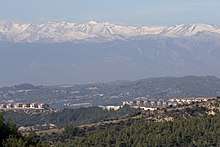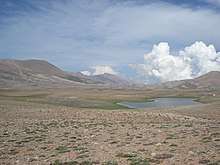Bolkar Mountains
Bolkar Mountains, also known as Bulgar Dagh[1] or Bolghar Dagh,[2] are a mountain range situated in the middle part of the Taurus mountains complex in southern Turkey bounded by the Göksu River to the west and the Pozantı River to the east. The northern part of the mountains lies in Niğde province, while the southern peaks rise in Mersin province.
| Bolkar Mountains | |
|---|---|
| Highest point | |
| Peak | Medetsiz |
| Elevation | 3,524 m (11,562 ft) |
| Dimensions | |
| Length | 25 km (16 mi) |
| Width | 80 km (50 mi) |
| Geography | |
| Country | Turkey |
| Region | Konya, Niğde and Mersin |
| Parent range | Taurus mountains |



Economy
In the early 20th-century, the mountains were noted as having large amounts of lead. A mine active in the region since 1825 was Bulgar Maden. As of 1920 it was still producing lead as a Turkish government ran enterprise. The ore from this mine was 44.2 percent lead. Silver and gold were occasionally found in the mines. The mine used a low quality smelting technique, which often threatened the quality of the product, leaving much of it lost. The gold and silver findings were sent to Istanbul for smelting.[1]
Fauna
Montivipera bulgardaghica is a venomous viper species endemic originated from this mountain range.
References
- Prothero, G.W. (1920). Anatolia. London: H.M. Stationery Office. p. 102.
- Køppen, Adolph Ludvig (1854). The World in the Middle Ages: An Historical Geography, with Accounts of the Origin and Development, the Institutions and Literature, the Manners and Customs of Three Nations in Europe, Western Asia, and Northern Africa, from the Close of the Fourth to the Middle of the Fifteenth Century, Volume 1. D. Appleton. p. 208.